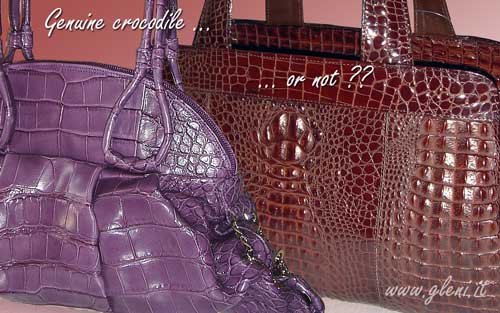Is your handbag genuine crocodile or alligator? How to tell…
* For a fuller, more detailed version of this article read How to tell if your handbag is made of genuine crocodile leather on our Gleni website.
A crocodile handbag is the ultimate in luxury. The gorgeous soft leather is much in demand by top designers, and genuine, top quality crocodile and alligator skin is very expensive. So it’s not surprising that there are cheaper alternatives about that try to reproduce the patterns and look of crocodile at a more affordable price.
 Ordinary leather embossed or stamped with a crocodile pattern can be made to look almost indistinguishable from the real thing. Caiman, which is often sold as crocodile by unscrupulous or ignorant dealers, while having similar scales and patterns to crocodile makes an inferior quality leather to crocodile and alligator, without the softness and suppleness that give them their luxurious feel.
Ordinary leather embossed or stamped with a crocodile pattern can be made to look almost indistinguishable from the real thing. Caiman, which is often sold as crocodile by unscrupulous or ignorant dealers, while having similar scales and patterns to crocodile makes an inferior quality leather to crocodile and alligator, without the softness and suppleness that give them their luxurious feel.
Here at Gleni we get many e-mail queries, asking whether a bag is genuine crocodile or not. Unfortunately, though we would love to help, it is impossible to give an accurate judgment just by using an e-mailed photo without the actual bag in front of us, so we have put together a few pointers to help you understand the differences between genuine crocodile and alligator leather and cheaper imitations.
Telling the difference between a stamped leather and genuine crocodile
- The patterns of scales: in a stamped leather the design is often too regular and repetitive without the natural variations of genuine crocodile.
- The thickness of the leather: a stamped leather will be of a uniform thickness, while genuine crocodile is more likely to vary in the thickness of scales and wrinkles.
- The feel of the leather: while some good quality stamped leathers can get close to the softness and pliability of crocodile leather, you can tell cheaper imitations just by touching the leather, which will be harder and less flexible.
- Large bags made of crocodile will usually use more than one skin, as the best crocodile comes from younger and smaller animals whose skin is still soft and flexible. So if you have a large tote that seems to have been made from one piece of leather with no stitched joins, it is probably made from stamped leather.
- The price: genuine crocodile or alligator is expensive. If you find a crocodile bag that is surprisingly cheap, perhaps 200 to 600 dollar or euros, then it is sure to be either a stamped leather product, or one made with illegally obtained crocodile skin that is unlikely to have been well tanned and produced.
Telling the difference between crocodile, alligator and caiman
- The pliability of the leather: one of the qualities that makes crocodile and alligator such a prized luxury is the softness and suppleness of the leather. Caiman skin is much less flexible and if you fold it light cracks will appear between the scales.
- The feel of the leather: caiman is much rougher and harder to the touch than either crocodile or alligator
- The scales: caiman scales are squarer and more regular than the patterns on crocodile and alligator, and their surface is crinkled with a pattern a bit like a finger print.
- The coloration of the leather: the soft smooth scales of crocodile and alligator take up the dye in a very homogenous and even way. Caiman is rougher and the dye shows up the natural wrinkles, so the coloring is likely to be uneven and sometimes even splotchy.
- The horned scales on the back: at the back of the neck on all three animals is an area of horned or bumpy scales. This leather is often used as a feature on wallets and bags and you can tell which animal the leather comes from , by the distribution of the scales. Alligator horned scales form the pattern 2-2-2; crocodile are in the design 4-2; the caiman pattern is 4-4-2.
Certification
Any crocodile bag that has been imported from another country will come with CITES documents that give all the details of the animal species the leather comes from, the number of skins used to produce the bag and the provenance of the skins. If the bag is being sold within the country it was made in, it might not come with these documents but any reputable retailer should still be able to give you detailed information about the leather and its provenance. Ask lots of questions before buying your bag.
As you will have gather from the above, when you are looking at a bag to ascertain its authenticity, it is important to be able to hold it in your hands, to get an impression of the feel of the leather, its softness and pliability. If you are buying a crocodile bag from a photo, only buy from a reputable company that specializes in exotic leather, so you can be sure of buying a top quality crocodile leather that has been expertly tanned and has certificates to prove its provenance. That way you will get a genuine top quality crocodile handbag that you will be able to enjoy for many years.
For a fuller, more detailed version of this article read How to tell if your handbag is made of genuine crocodile leather on our Gleni website.




I enjoy looking at your site. Thanks for your time!
Really informative and excellent bodily structure of content material, now that’s user genial (:.